We all know what they are, but carburettors are also one of the most misunderstood items under the bonnet — here’s a look at how your average Holley four barrel works
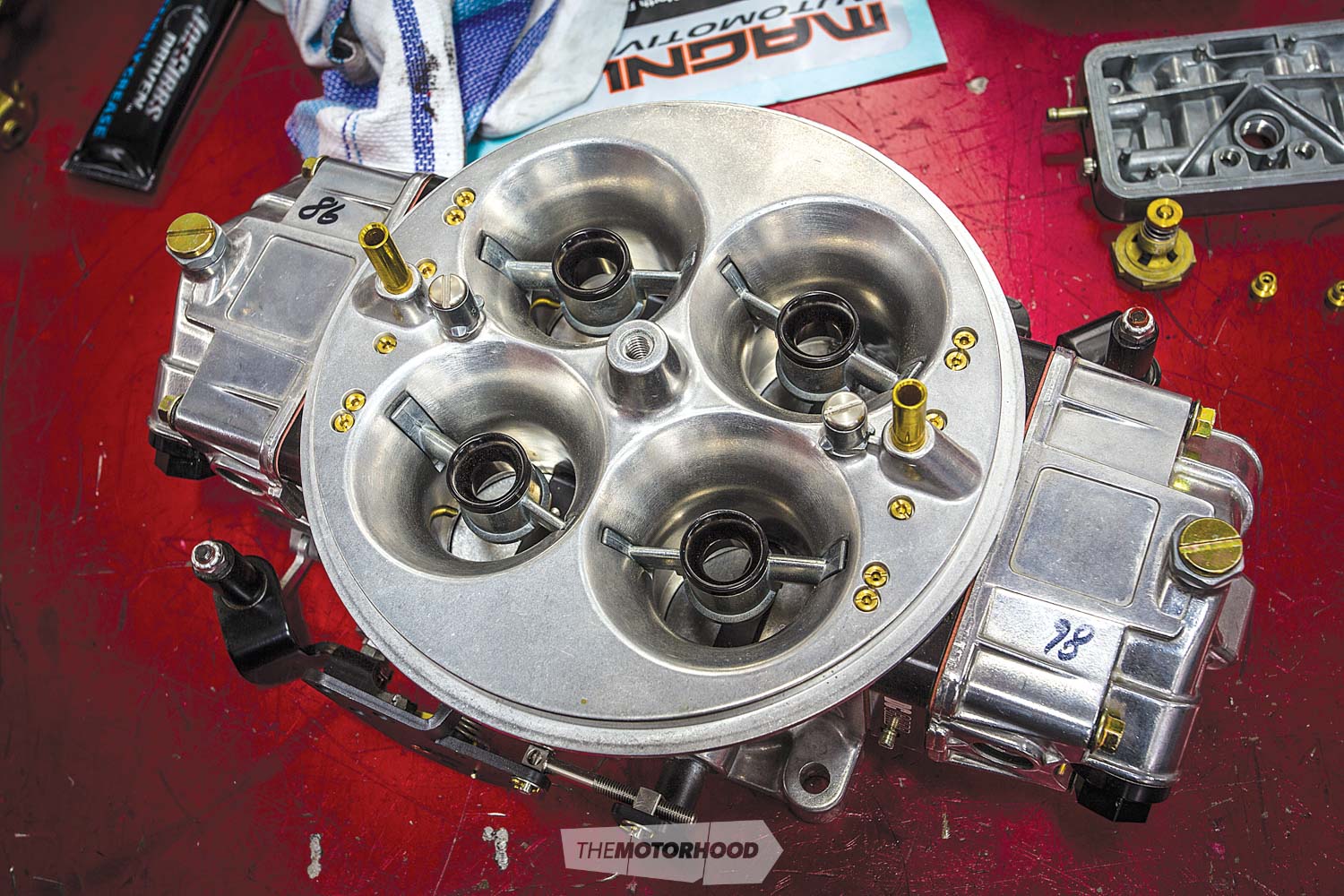
A carburettor is one of the most misunderstood parts of an engine, but its basic operation is actually not too confusing. Due to changes in air pressure related to throttle position and engine speed, the fuel follows a passage before it is atomized (emulsified) with air and drawn into the combustion chamber. To understand how this works, we need to understand Bernoulli’s principle, which states that the velocity of a gas is directly related to its pressure.
Pressure will always try and regulate itself. So, as the piston travels down the cylinder on the intake stroke, its downward motion creates a vacuum that must be filled. The vacuum means that the pressure within the cylinder is less than the atmospheric pressure outside the engine, and the pressure differential is equalized by atmospheric air being sucked into the cylinder through the carburettor. Just as this pressure determines how much air flows through the carburettor, it also controls how much fuel is mixed with this air to maintain an optimal air to fuel ratio (AFR).
As the venturis are the narrowest point of the intake path, airflow through them is at its highest velocity, and therefore lowest pressure — according to Bernoulli’s principle. The airflow through the carburettor venturi — determined by engine speed and the position of the throttle blades — also creates a vacuum effect, drawing fuel from the carburettor’s fuel bowl, which is then mixed with the air (emulsified) to create an atomized air–fuel mixture.
As intake air velocity increases, the resulting change in pressure also changes the quantity of fuel supplied — hopefully maintaining an acceptable AFR. The intention is to set the carburettor up for the specific engine, to get as near to perfect an AFR as possible under all engine operating conditions.
The stoichiometric AFR for gasoline is 14.7:1 — this is, in theory, the exact ratio of fuel to air required to utilize both completely. That is, one part fuel to 14.7 parts air will see all the air burnt, and all of the fuel used to do so. In practice, tuners will aim for a slightly richer AFR — roughly around 13:1 — due to its propensity to produce more usable power in the real world, and for the reduced risk of detonation, which may occur should an engine be run too lean.
How it works
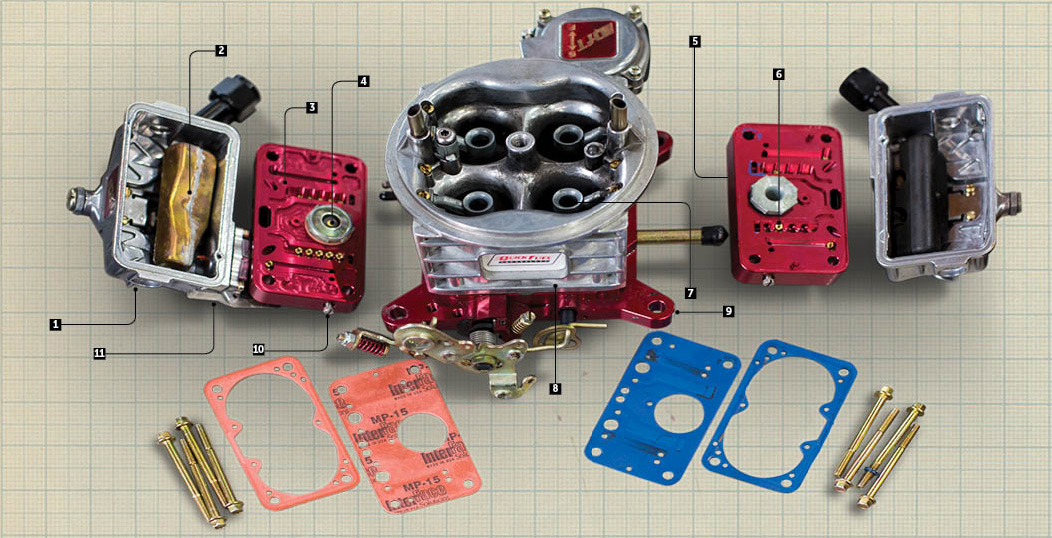
Fuel is pumped through the fuel lines into the carburettor fuel bowl — this is where the carburettor’s inner workings really begin. From the fuel bowl, fuel is metered through the main jets and into the main well within the metering block, at a level equal to that within the fuel bowl. In the main well, the fuel is emulsified with air that enters via the air bleeds in the throat of the carburettor, and the atomized air–fuel mixture is discharged from the venturi booster within the throat of the carburettor barrel. But what are all these parts? Read on to find out:
1. Fuel bowl
The fuel bowl is the fuel’s first destination within the carburettor. The fuel bowl holds a volume of fuel that will be metered into the intake air to provide an air and fuel mixture for the engine. The amount of fuel held in the bowl is regulated by the float, which utilizes a needle and seat system.
2. Float
The float is a hollow cannister that resides within the fuel bowl, and determines the amount of fuel that enters the carburettor. On a standard Holley four barrel, correct float level is set by opening the sight hole on the side of the fuel bowl and, with the motor running, adjusting the float level until the fuel in the bowl is level with the base of the sight hole.
3. Metering block
A carburettor metering block is a key component in metering the fuel with which the engine is supplied. Fuel from the fuel bowl passes through the main jets at the base of the metering block, and collects in the metering well within the metering block, at a level equal to the fuel in the bowl. It is within the main well that the fuel is mixed with air.
4. Power valve
The power valve is a vacuum-actuated valve that enriches the mixture by allowing more fuel into the emulsion well as it opens — this helps the fuel supply to keep up with increasing airflow at higher engine speeds. The power valve opens and closes at a predetermined level of manifold vacuum. Most Holley four-barrel carburettors will have a stamp on the power valve identifying opening pressure. The most common are stamped with a ‘6’ and ‘5’ — this shows that the power valve will open to enrich the mixture when the manifold vacuum drops below 6.5in/hg (inches of mercury — a measure of barometric pressure). This is a suitable power valve for most engines, but for those running aggressive-profile cams, or intake systems with low idle vacuum, it may be beneficial to switch to a lower numbered valve to save the power valve being open upon idle — the lower the number, the later the valve opens.
5. Main jets
The jets determine how much fuel is delivered from the fuel bowl into the metering block. They are small plugs that are threaded into the base of the metering block, and can be changed out for smaller or larger units to suit an engine’s requirements — changing the jet sizing helps to fine-tune an engine’s AFR to be as close to optimal through as much of the engine’s operating range as possible.
6. Emulsion tube
The emulsion tube is hollow, with holes drilled through it at several points. It extends down into the main well in the metering block, and the holes in it help to mix the fuel with air. As was mentioned earlier, the fuel enters the main well via the main jets. The air, on the other hand, enters via an air bleed, which, in most Holley-style four-barrel carburettors, is located near the opening of the venturi. By changing the diameter of the holes in the emulsion tubes, the AFR can be adjusted to better suit the engine’s requirements. On high-performance carburettors, the emulsion system may comprise a series of adjustable jets, permitting minute adjustments to the mixture.
7. Venturi booster
After emulsification via the emulsion tubes, the air–fuel mixture travels through a passageway and exits from the booster, which is located within the venturi. The aim is for the most efficient extraction of the air–fuel mixture from the booster and into the venturi. This is where, like every other carburettor component, the boosters must also be optimized to suit the application, through size and design. The booster’s position within the venturi ends around the venturi’s minor diameter, which sees the highest velocity of airflow passing through it. The narrow throat of the booster further enhances air velocity, amplifying any changes in inlet pressure — this allows for greater tunability and finer atomization of the fuel.
8. Main body
The main body of the carburettor contains the venturis, through which intake air flows to commence the fuel delivery process. Its design also incorporates various circuits for the transfer of air and fuel between the fuel bowl and the booster.
9. Throttle body
The throttle body is a plate or section of the carburettor that houses a set of butterfly valves, or throttle blades. The angle of the throttle blades, controlled by the accelerator pedal, effectively determines the engine speed — as the throttle blades open further, more air is allowed past, which in turn feeds more fuel, allowing for a bigger combustion cycle.
10. Idle circuit
The idle circuit bypasses the carburettor’s tendency to deliver fuel only when the throttle blades are open and air is flowing through the venturis. The idle circuit utilizes idle air bleeds to allow the engine to receive fuel when the throttle blades are closed. The air–fuel mixture upon idle can be fine-tuned via the mixture screw located on the side of the metering block.
11. Accelerator pump
The accelerator pump is designed to supply fuel to the engine when the throttle blades are opened suddenly and more air than fuel flows through the venturi, thus upsetting the AFR — otherwise the engine would initially stumble as it momentarily ran lean, which would defeat the purpose of opening the throttle. Accelerator pumps are, essentially, an insurance policy against running lean. One accelerator pump is sufficient for most carburettors, but some mechanical secondary carburettors come equipped with two accelerator pumps — these carbs are also known as ‘double pumpers’. Having one accelerator pump for each set of venturis aids fuel delivery and throttle response in high power, and high airflow, applications.
Carl Jensen (C&M Performance) says:
“I rate modern carburettors, like those manufactured by Quick Fuel, because of the tunability you can get with things like adjustable emulsion circuits. I’ve only had good experiences with them. Back in the day, a carb like this [photographed] would have cost you around $3000; nowadays, you’ll buy something like it for $895.
“Quick Fuel, Holley, and all the big manufacturers now make carbs specifically for alternate fuels, such as E85. It’s usually easier just to buy something specifically for that, rather than to convert a carb to run a different fuel.”
Eric Livingstone (West Auckland Engine Reconditioners) says:
“On a poorly running car, with a suspect bad carburettor, check the basics before ripping the carb apart. Ensure the engine is mechanically sound, the compression is OK, and the ignition is up to the job for the type of engine — MSD or equivalent is great. Make sure the initial ignition timing and the advance curve are correct for the engine specs, and the spark plugs are clean. Make sure there are no vacuum leaks, and the carb should also be correctly sized for the engine. The best carburettor money can buy will never run 100 per cent if any of the above is substandard.
“Set the float levels, and then run the car on a dyno — this puts load on the engine at various speeds and rpm, and identifies the air–fuel ratio as each circuit comes into play: idle, transition, mains, and power valve.”
Carburettor types
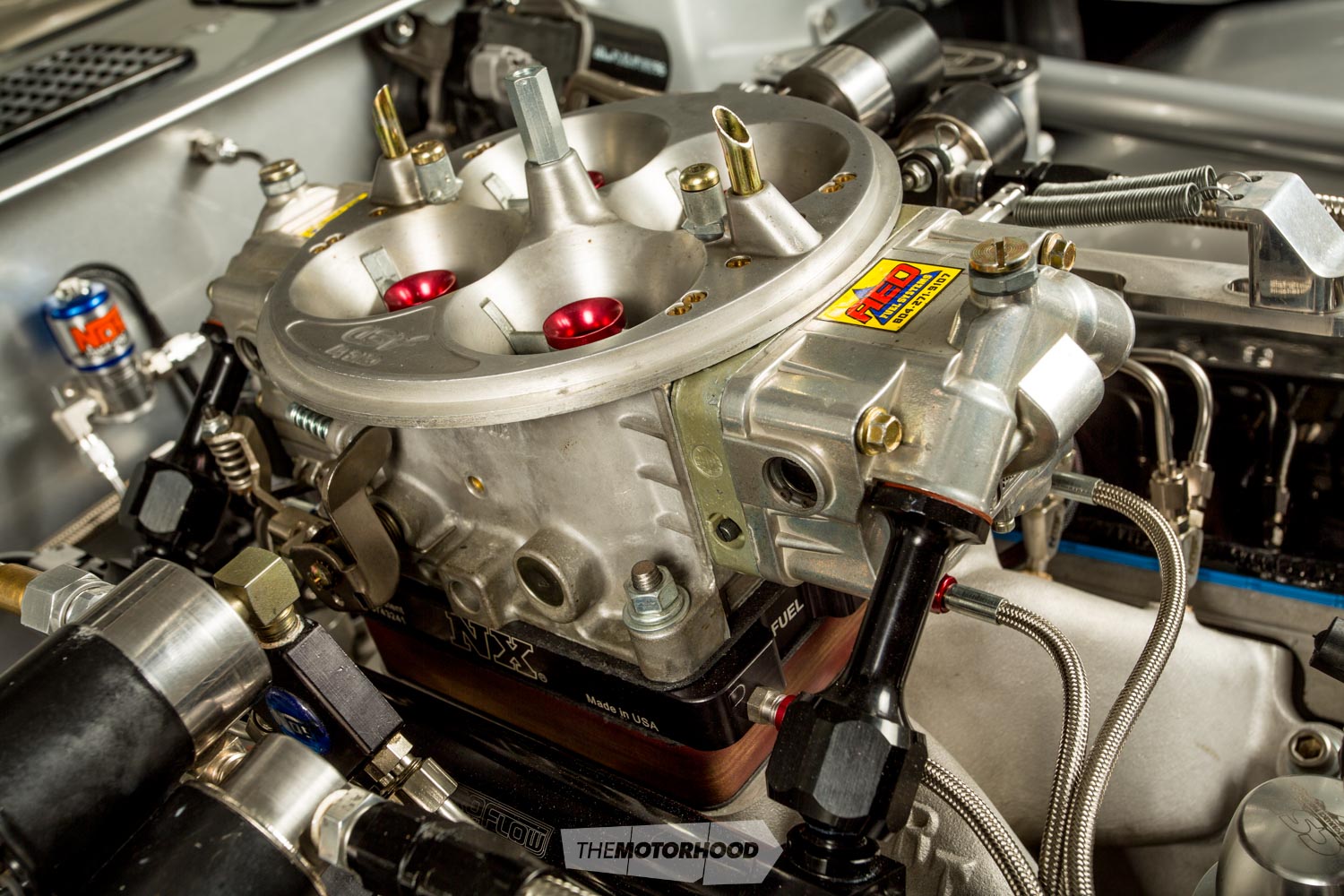
Double barrel
Going up by one in the barrel count over early-style single-barrel carburettors, a double-barrel carburettor gains an additional venturi. This allows for increased airflow through the carburettor, and therefore a propensity for the engine to produce more power. A lot of old high-performance engines featured multiple double-barrel carburettors, allowing for far more airflow than could flow through one, or more, single-barrel carburettors. Notable examples include Chrysler’s Six Pack–equipped engines, which left the factory with a trio of Holley two-barrel carburettors up top, and the Stromberg 97s and Edelbrock 94s that adorn many a hot rod’s intake manifold.
Four barrel
Four-barrel carburettors became widely popular in the 1960s, as manufacturers realized that a well-designed four-barrel carburettor could perform better under all situations than multiple double-barrel carburettors. The Rochester Quadrajet, introduced in 1965, featured the ‘spread bore’ design, which used small primary venturis relative to the much larger secondaries — hence, a spread between the barrel bore sizes. The small primaries allowed strong, low rpm throttle response and fuel economy, thanks to better air velocity through the small venturis, with strong open-throttle performance still available when the larger secondaries were opened. Some of the wilder American muscle cars of the era were even fitted with two four-barrel carbs — ‘dual quad’ is the common notation — to satisfy the enormous engines’ thirst for air and fuel.
John Mincham (Magnum Automotive) says:
“The four-barrel carburettor has been the benchmark for performance V8 engines for more than 50 years. Over the last 10 years, these have become easier to tune, with most circuits having screw-in jetting. The Holley-style carburettor is still king, with companies such as Quick Fuel marketing Holley-based product as well. Many companies offer custom modified Holley-based carburettors for the more serious user.”
Double pumper
Most Holley-style four-barrel carburettors with vacuum-actuated secondaries have one accelerator pump on the primary side. However, some mechanical secondary carbs come equipped with two accelerator pumps — one on the primary side and one on the secondary side — which are known as double pumpers. This is normally of benefit in large-capacity, large-power engines that require plenty of air and fuel; the additional accelerator pump minimizes bogging when the secondaries open.
Grant Rivers (Rivers Speed & Spares) says:
“Our experience with cars and carburettors today is that a lot of people want power and economy, which was not easily achieved with older carbs. In comparison with its leaded counterpart, our [modern] fuel is not as efficient on some older, worn carbs. Engine efficiency plays a big part — get that right, and the correct carb for the application, and tuning is easy.
We have found on our dyno that the Quick Fuel series is one of the best in relation to value for money, and is easy to tune. Don’t get me wrong: Holleys are just as good, but, bang for buck, we prefer Quick Fuel — there are a lot of options to suit your requirements, and they’re very tunable.”
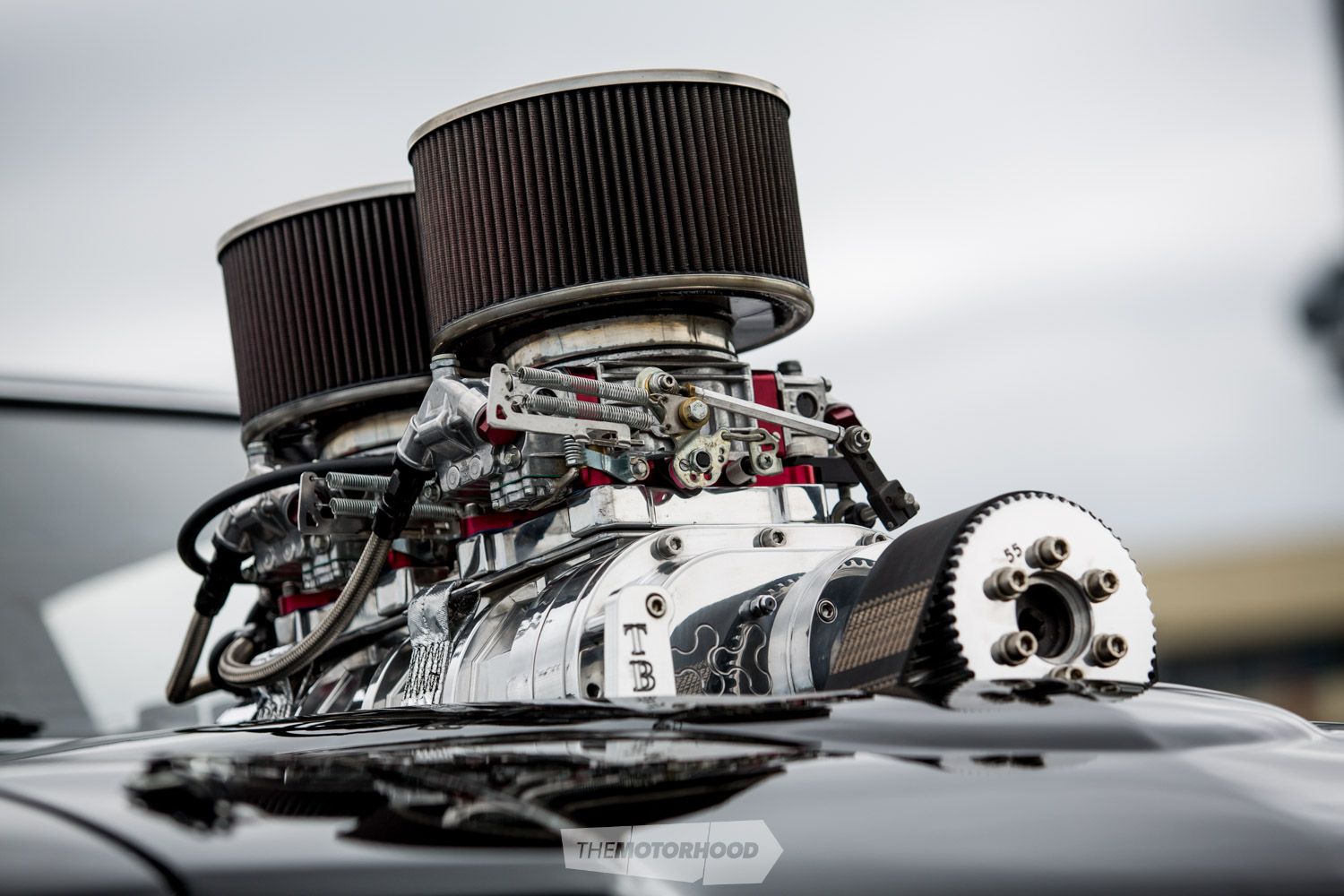
Boost reference
Generally, when a carburettor has been ‘boost referenced’, it has been modified for use with a Roots-type supercharger, by receiving a vacuum signal from the inlet manifold beneath the supercharger. This modification essentially reroutes the power valve’s original intake air circuits to a vacuum hose, which can be plumbed into the intake manifold — hence, the carburettor’s power valve will receive a vacuum signal from beneath the supercharger’s rotors, rather than above, which is more accurately representative of the engine’s requirements for air and fuel.
Al Shadwick (Als Blower Drives) says:
“For most mild, supercharged street engines, boost referencing the power valve is not necessary, particularly with dual carbs. However, there are a few things to consider. The first involves part-throttle situations, where there can be boost pressure below the blower and vacuum above it.
“This is important in supercharged street engines, where the engine can go into a boost situation before the throttle is fully open — the power valve, which in a normally aspirated engine would receive its vacuum signal from the intake manifold, may still see a vacuum signal causing it to stay closed. This is more likely to happen with a very mild cam, trapping boost, and with more restrictive engine airflow, such as with smaller heads, or headers.
“The second consideration is that in any engine, boost referencing — which pushes or holds the power valve open under boost — may be desirable when the carburettors are comparatively small for the given application, or on a single-carburettor supercharged engine. In any supercharged street or race engine where blower speed is up, or where the engine will see a lot of part-throttle — part-throttle is where power valves are really a benefit — boost referencing would be highly desirable. Remember, power valves are part of the carburettor’s main fuel system.”
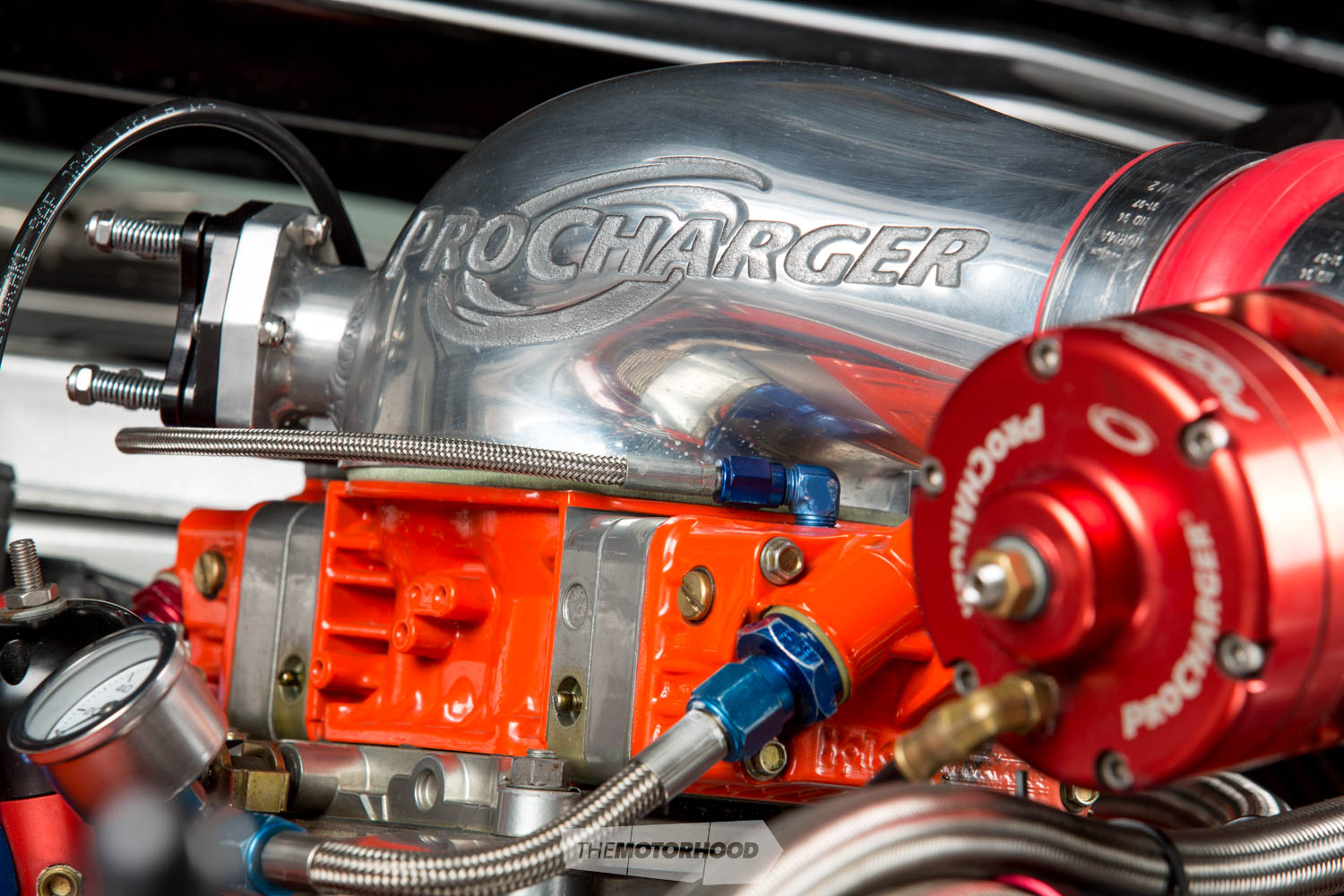
Blow through
When forced induction and carburettors are put together, the carburettor may require modification to function properly — especially if the pressurized air is coming from upstream, such as with a turbocharger or centrifugal supercharger. Carburettors that have been modified to function in such set-ups are known as blow-through carburettors. A blow-through carb requires some trickery to ensure the carburettor can not only cope with the boost pressure but also work optimally. While most carb specialists won’t give away all their tricks, with some expert knowledge it is possible to make blow-through set-ups work well. During modification, it’s not uncommon for the factory brass floats to be discarded and replaced with floats that are constructed of a solid Nitrophyl material, as the stock ones are hollow and can implode under high-boost pressure. The power valves are also often modified, and that can require the floats to be clearanced. Power valves are also used on both sides of the carburettor, letting in a little fuel from each side and allowing the opening points to be staggered to provide for more tunability. Each side can be set up to open at a different boost level to allow for a stable AFR throughout the boost range.
Carl Jensen (C&M Performance) says:
“A lot of guys are building blow-through carbs, and blow-through carbs only. We’ve found it’s not really worth messing around converting carbs to blow-through, when you can just get the experts to build one — we use Carburetor Solutions Unlimited in Fontana, California. I reckon they probably do the best blow-through carbs in the world.”
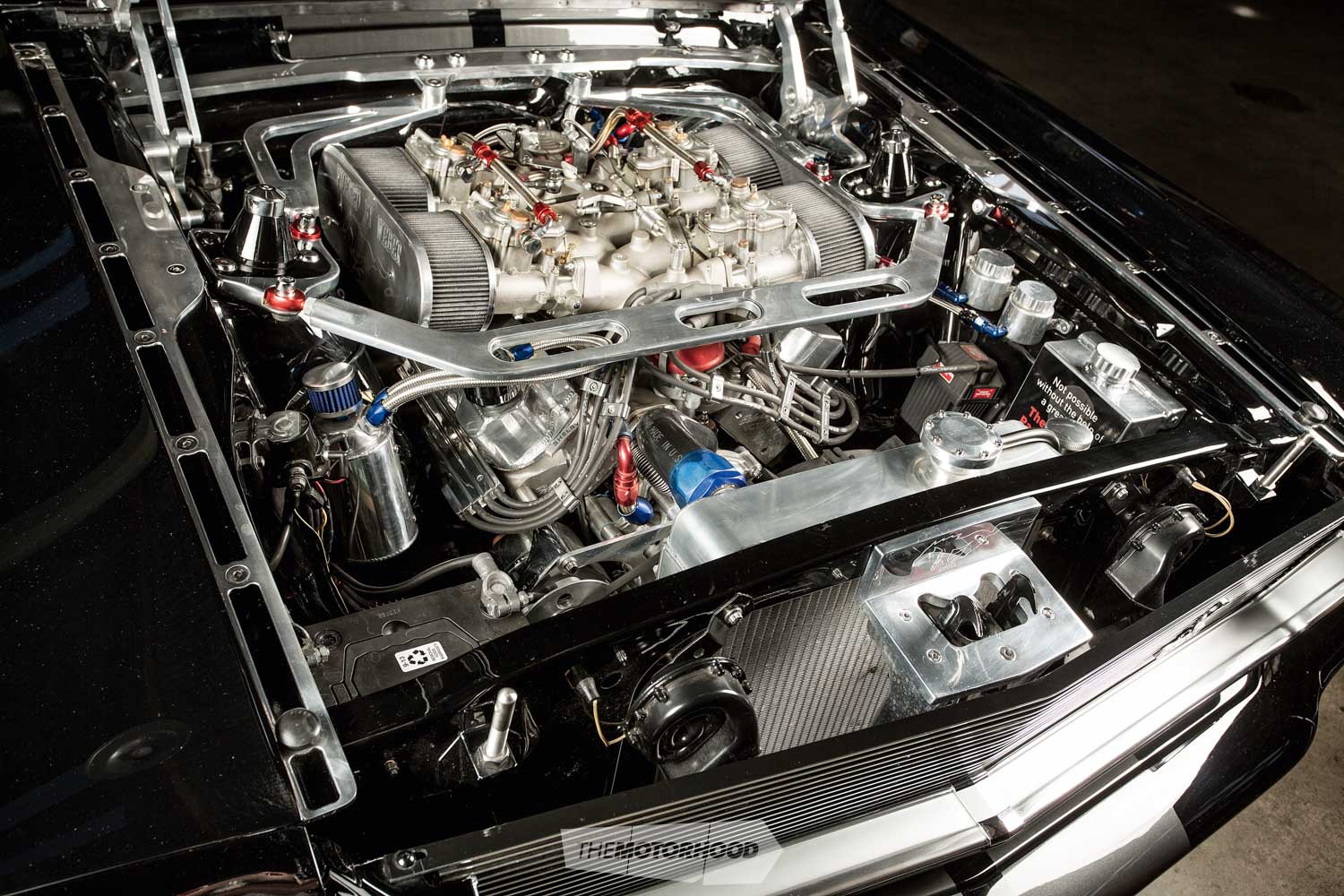
Sidedraft
Most carburettors in both production and aftermarket applications are of the downdraft type, where air flows in a downwards direction through the carburettor. A sidedraft carburettor is mounted on a horizontal plane, with inlet air sucked in ‘sideways’. Its construct differs from downdrafts in that the float bowl and fuel circuits must be designed differently, due to gravity. Sidedraft carburettors, such as those manufactured by Weber, Dellorto, SU, Solex, Mikuni, and others, are therefore quite popular on inline-style engines, with inlet ports located on the side of the cylinder head — a sidedraft carb will, in this application, offer a direct inlet path with no 90-degree bend, and thus result in improved high-rev breathing potential over a downdraft carburettor. Even so, there are aftermarket manifolds that allow the use of sidedraft carburettors on conventional V8 engines. While four Weber DCOE sidedraft carbs on top of a V8 won’t be the easiest or cheapest to set up, they’ll look, sound, and perform well enough to more than make up for it.
Vacuum Versus Mechanical Secondaries
A typical four-barrel carburettor runs two sets of venturis, known as the primaries and secondaries respectively. The primaries are generally smaller diameter venturis that are active when the engine is running at low speed or under low load. At low-throttle, low-power operation, having all four barrels open means less airflow through each venturi. Running off two barrels at low throttle therefore allows for better fuel metering. Under acceleration, the larger secondary venturis open, allowing more airflow — and therefore more fuel — which translates to more power.
In most engines, vacuum-operated secondaries are optimal, utilizing vacuum to determine when the secondary venturis are opened. However, in angry, high-performance motors, with intake vacuum issues, a vacuum secondary carburettor can prove inefficient. In these instances, a mechanical secondary carburettor is often preferred. This utilizes a mechanical actuation of the secondaries, by a series of physical linkages, which progressively open the secondary throttle blades. On a regular street-driven motor, a mechanical secondary carburettor will probably be far less fuel efficient than an equivalent vacuum secondary carb.
John Mincham (Magnum Automotive) says:
“Vacuum secondary carburettors are best suited to stock to mild performance applications. They work well in street-driven applications where the user wants smooth, seamless power. The vacuum secondary carb will also size itself to the application if the chosen carb is a little large. The secondary butterflies will open up only as far as the engine demands. Most modern vacuum secondary carbs have easy adjustment for speeding or slowing down secondary application.
“Mechanical secondary carburettors are best suited to hot street, strip, and race applications. The general jetting of a mechanical secondary carb is to the rich side, showing that it’s more for race than day-to-day street driving. With the mechanical secondary carb, the driver controls the rate at which the secondaries open with the loud pedal. Sizing of a mechanical secondary carburettor has to be more in the ballpark, as, at full throttle, everything is open.”
What Size Carb?
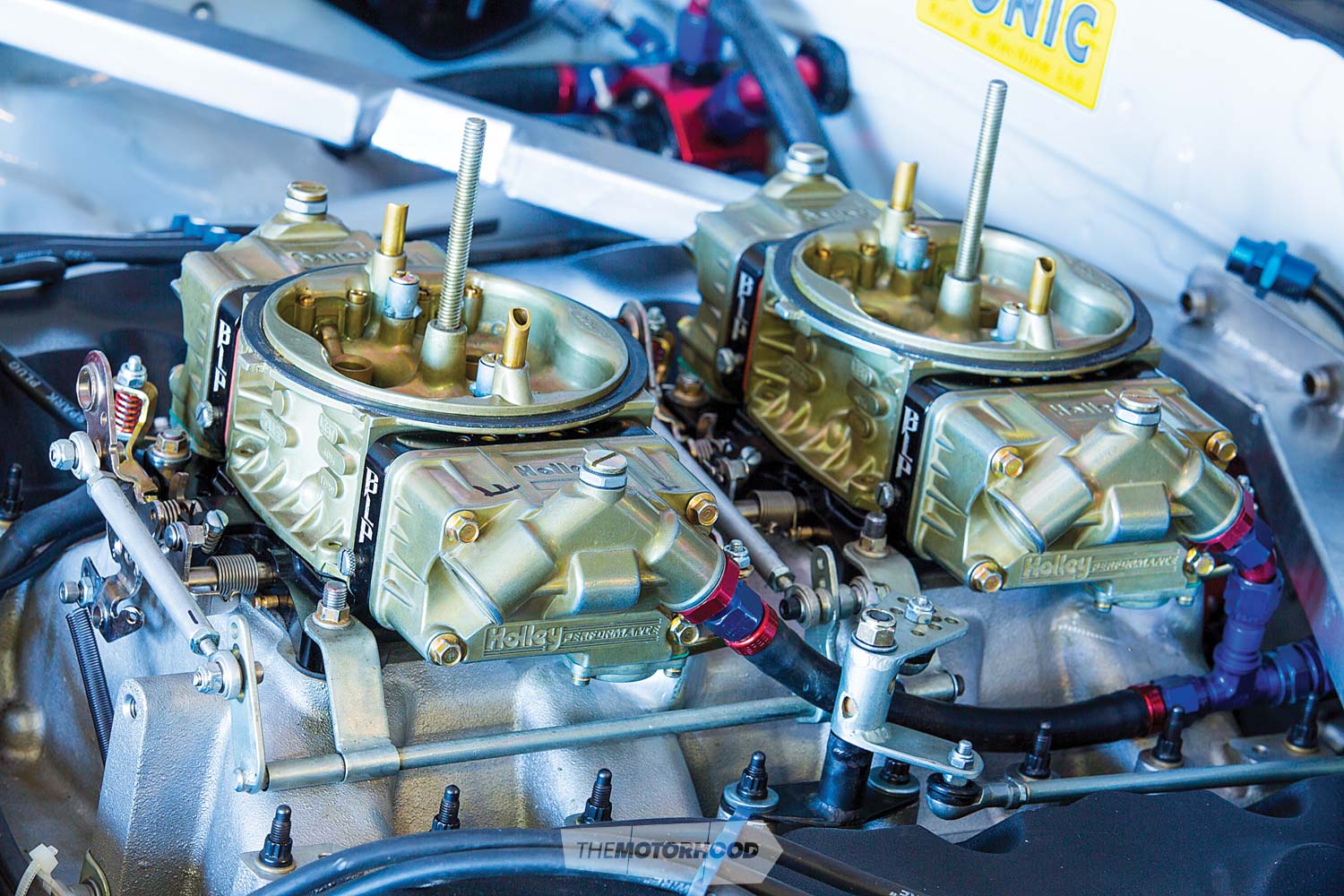
The volume of air that a carburettor is able to flow is measured in cubic feet of air a minute (CFM). As a rough rule of thumb, a suitable carburettor for an engine can be determined by taking into account the engine’s displacement in cubic inches (CID) and maximum operating rpm. So, for a 406ci small-block Chev set up for the drag strip, which would see a maximum of 7000rpm, we can use the following formula:
Optimal CFM = (CID * max RPM) / 3456
Optimal CFM = (406 * 7,000) / 3456
Optimal CFM = 822.38cfm
So, with an optimal carburettor flowing 822cfm, and known performance intention for the engine, we could use, for example, a Holley 850cfm Double Pumper as a good starting point. This formula assumes the optimal CFM for an engine to operate at 100 per cent volumetric efficiency (VE).
John Mincham (Magnum Automotive) says:
“It is easy to overestimate the size of the carburettor your application requires. The formula — (CID * RPM) / 3456 * VE — gets you in the ballpark. It is critical that you are realistic with your VE. Most street performance vehicles will fall in the 80–100 per cent range.”
Volumetric efficiency
The ability of an internal combustion engine to draw intake charge into, and expel it from, the cylinders is referred to as volumetric efficiency (VE). It is normally referred to as a ratio or percentage of the volume of air that is drawn into and remains in the cylinder during induction, compared with the cylinder’s swept volume.
This article originally appeared in NZV8 magazine issue No. 134 — you can get your grubby mitts on a copy by clicking the cover below





